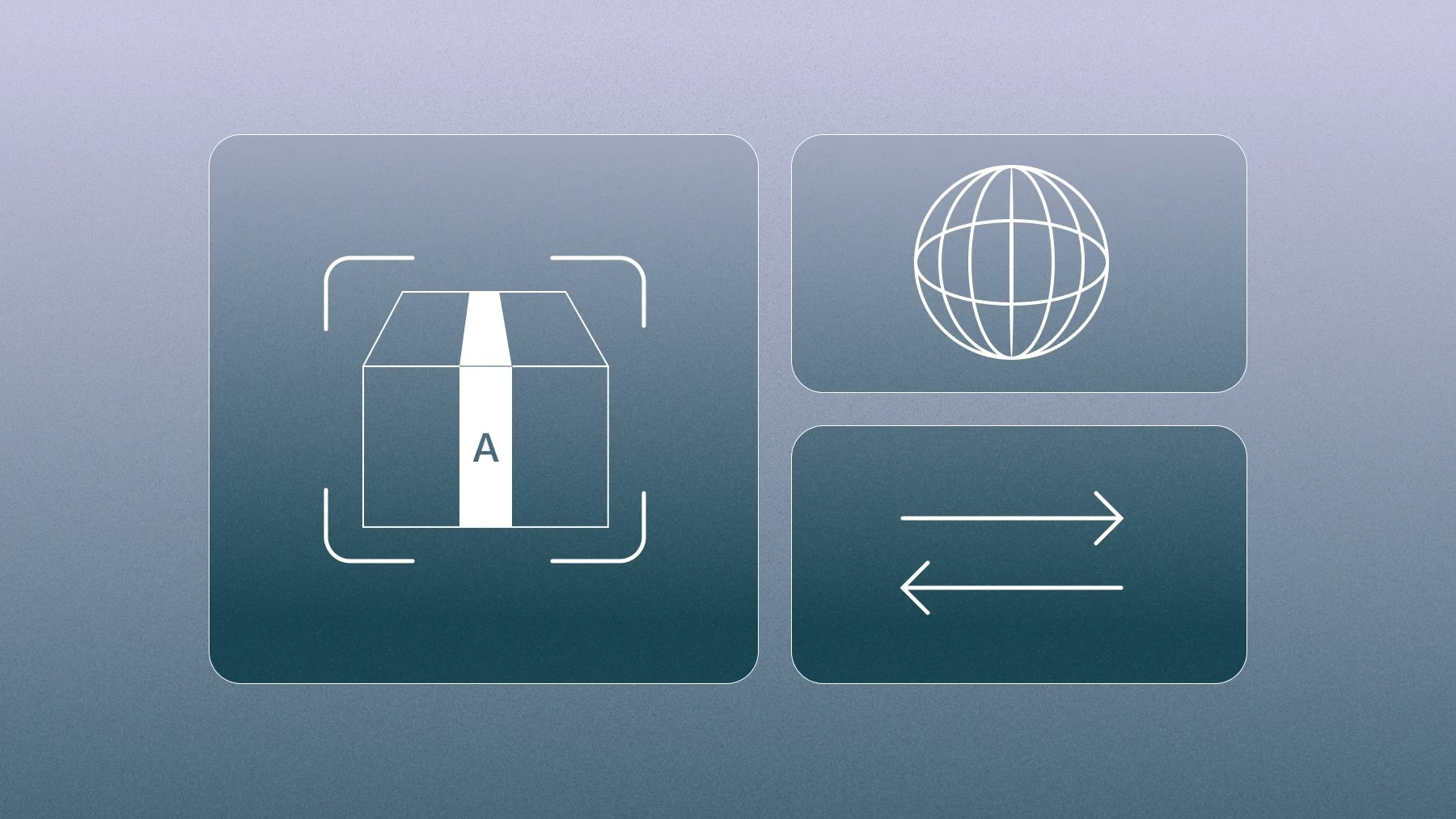How to set up dropshipping with Alibaba

Any ecommerce business has to consider order fulfillment. Depending on the product, you might consider print-on-demand, white labeling, wholesale sourcing and selling, custom products, or dropshipping.
If you’re planning to launch a dropshipping business, you’ve likely heard of Alibaba, one of the largest wholesale marketplaces in the world. Alibaba is often used to source products from international suppliers, primarily ones in China. The marketplace can open doors to a wide range of product offerings and low-cost dropshipping services — but you have to learn the ropes first.
In this article, we’ll outline the pros and cons of dropshipping on Alibaba, some tips to help you get started, and how to vet trustworthy suppliers.
Key takeaways:
- Dropshippers can be successful on Alibaba, but it's important to vet suppliers closely.
- Tools like Alibaba's Trade Assurance coverage can help ensure that suppliers are high-quality
- Keep the pros and cons in mind when working with Alibaba.
What is Alibaba?
Alibaba.com is a global wholesale marketplace owned by Alibaba Group, a Chinese multinational tech company that also owns other shopping platforms like AliExpress, Taobao, and Tmall. Alibaba.com (from now on referred to as Alibaba) specifically is a platform for business-to-business (B2B) products, boasting one of the most extensive directories connecting suppliers (primarily from Asia) from buyers around the world. Whatever product you’re looking for, you’ll likely find it on Alibaba.
How does Alibaba work and how is it different from AliExpress?
Alibaba.com is a global wholesale marketplace owned by Alibaba Group, a Chinese multinational tech company that also owns other shopping platforms like AliExpress, Taobao, and Tmall. Alibaba.com (from now on referred to as Alibaba) specifically is a platform for business-to-business (B2B) products, boasting one of the most extensive directories connecting suppliers (primarily from Asia) from buyers around the world. Whatever product you’re looking for, you’ll likely find it on Alibaba.
Does Alibaba dropship? Yes! Alibaba and AliExpress are dropshipping platforms, but they fit different needs depending on your scale. To begin with, AliExpress is a business-to-consumer (B2C) marketplace for everyday consumers. Dropshippers with low-volume orders can purchase products directly from suppliers on the AliExpress platform without minimum order quantity requirements. AliExpress also offers ePacket shipping, which expedites shipping from China and Hong Kong to select international countries.
Meanwhile, Alibaba operates as a business-to-business (B2B) wholesale marketplace. It primarily caters to buyers, retail agents, and trade businesses looking to purchase from suppliers that offer products in large quantities at low prices. As a buyer, you’ll find that you can purchase directly from manufacturers that are selling private-label products — you’ll be able to negotiate directly with them, too. Because some Alibaba suppliers only require a one-piece minimum per order, it’s still a good option for dropshippers.
How do you dropship on Alibaba?
So how exactly does dropshipping work on Alibaba? We’ve laid out a series of steps you can follow and tweak to your own dropshipping strategy:
1. Decide on the products you want to sell
Use the search function in Alibaba’s Dropshipping Center to explore dropshipping products that are on sale and have no minimum purchase quantity. You can choose between niche products that have less competition and popular products that already have a confirmed market. Many dropshippers choose niche products to stand out from other sellers.
From there, you can use Alibaba’s “bought together” feature to browse additional products consumers have bought with the item you’ve searched for. Be warned: This is not the best strategy if you’re trying to build a niche. Following these recommendations will only uncover the same string of products that other stores are adding to their sites.
2. Search the products on Alibaba
Alibaba has a vast database of suppliers, manufacturers, and factories that list similar products. For example, if you’re looking for coffee mugs to sell, you will find thousands of products available from different suppliers. You’ll need to compare a few listings to see which source has the best product for your business.
Read the product info as well as the packaging and delivery details to help determine what products you want to list in your store. Pay close attention to things like:
- Per-unit price
- Minimum order quantity
- Shipping costs
- Estimated lead time for processing
- Guaranteed delivery date
- Accepted payment options
- Verified Alibaba supplier icon
3. Select and contact Alibaba suppliers
Once you have a list of potential suppliers you want to move forward with, it’s time to contact them — whether by email, chat, or through an inquiry form on their product page, it’s up to you.
You can also find a supplier’s contact information on their Alibaba profile. This can be useful if you want to see other products or services that the supplier offers and read reviews from other buyers about their experience with the product and supplier.
When reaching out to a supplier, keep your message concise. Some good questions to ask include:
- Is there a minimum order requirement?
- What is their return policy?
- What is their shipping timeline?
Always communicate thoroughly and establish all terms with the supplier in writing, in case issues arise that require Alibaba’s mediation.
4. Negotiate pricing
By this step, you should have a handful of potential suppliers you’ve vetted and are seriously considering. As previously mentioned, you can negotiate pricing with suppliers on Alibaba. Negotiations take place over email.
To prepare for price negotiations, look at the supplier’s competitor listings for the same or similar product type. This can help you gauge your ideal price point per unit in the negotiation. Additionally, consider what you want your profit margin to look like.
5. Order product samples
Before settling on a supplier and placing an order from Alibaba, ask your suppliers for a sample of the product. Paying for a sample is an important step that helps you test the product quality and verify whether the physical product on Alibaba lives up to its listing description.
Some details you may want to assess include:
- Material quality
- Production quality (e.g. stitching, finish)
- Packaging (e.g., sufficient padding for fragile items, professional packaging)
- Product functionality
Ordering a sample can help you avoid later headaches from disgruntled customers who received a shoddy product. Samples allow you to inspect the product to see if it meets your specifications and give you an opportunity to address flaws, defects, or quality control issues with the supplier.
6. Place a test order with the supplier as if you’re a customer
The next step is ordering from the Alibaba supplier you’ve chosen. Placing an order as if you’re the customer can help you get a feel for your customers’ ordering experience, giving you a clear idea of the speed at which an Alibaba supplier processes your order, their shipping costs, and the quality of their packaging. It also offers you a second reference point to look over the product for issues.
7. Connect your storefront to Alibaba
If your test order goes well, you can connect your storefront to Alibaba and start selling the product. As we explain in “How to start a dropshipping business,” your storefront can be hosted on your website or launched through third parties like Shopify, BigCommerce, or Wix. Once you connect your storefront, the supplier will be able to fulfill your customers’ orders.
Alibaba’s Dropshipping Center can help you save time by eliminating manual tasks like submitting orders and payments individually that take time away from growing your business.
Automating the dropshipping process by linking your Alibaba account with one of its dropshipping partners, like Modalyst, Dropified, and Spocket will also give you the option to customize data and publish product info to your storefront.
How do you vet high-quality Alibaba dropshipping suppliers?
Finding a trustworthy Alibaba supplier for your business is essential to its success. Here are a few tricks of the trade that can help you make sure you’re not getting scammed:
1. Check for Alibaba’s Verified Supplier icon
Although you can order products from non-verified Alibaba suppliers, ordering from verified suppliers can give you confidence that their business has been vetted for authentication and on-site verification. Ordering from a verified supplier also gives you access to Alibaba’s free supplier inspection reports.
2. Ask for a business address and phone number
A legitimate supplier will have no issue providing their business’ address, email, and phone number. Call the supplier to confirm that the phone number listed is valid. Send an email and ask the supplier to reply.
3. Check the supplier’s Source’s Supplier Online Performance Index (SOPI)
Although Alibaba’s suppliers are located worldwide, many of the suppliers on its platform are in China. Suppliers in China are rated using Alibaba’s Source’s Supplier Online Performance Index (SOPI). This index has six levels from 0–5 that measure variables like presentation quality, product popularity, transaction volume, and service quality. The levels are depicted as diamond icons under the supplier’s name on a product listing. Level five is the highest SOPI classification.
4. Check for Alibaba’s Gold Supplier icon
Suppliers can also pay for an Alibaba Gold Supplier membership. Gold Suppliers agree to undergo on-site verification by a third-party inspector who also confirms that the business is a legal entity. It’s an extra step to ensure you’re dealing with a legitimate business.
5. Be prepared to walk away
If something seems suspicious, like an unusually low unit price or if the supplier is aggressively pressuring you to conduct business outside of the platform, take this as a red flag and be prepared to walk away. There are always more fish in the sea.
How to understand Alibaba's Trade Assurance protection
Alibaba’s Trade Assurance is another tool that can help protect your Alibaba orders. Under this assurance, if your supplier sends a product that either doesn’t meet the agreed-upon product quality or shipping date expectations, Alibaba will help resolve the matter. This includes getting a refund, if necessary.
The benefits of the Alibaba trade assurance are:
- Protection from product quality issues or shipping delays
- Convenient payment options, like credit card, online bank transfer, PayPal, and wire transfer
- Payment security so your funds are tracked and safely sent to the supplier
- Customer support up to 30 days after your order is delivered
- Mediation assistance for disputes with the supplier
- Reimbursed funds for eligible claims
There’s no additional fee for trade assurance protection, but your order must meet specific requirements to be eligible.
Keep in mind that while Alibaba’s Trade Assurance protection protects you for Alibaba orders, you’ll also want to choose the right business structure for your ecommerce business (such as an LLC or a corporation). Your business structure can offer additional liability and protect you from losses for transactions outside of Alibaba.
How to get Trade Assurance coverage
To qualify for Trade Assurance coverage, you must have ordered from a Trade Assurance supplier, which can be identified by a golden “Trade Assurance Supplier” icon under the “Protection” section of the product listing. To be eligible, you must also have paid for the order using Alibaba’s payment platform (as opposed to an off-site third party) and have initiated a claim within 30 days of delivery for a refund.
Alibaba’s support team bases its investigation on the on-site communication records between you and the supplier. Make sure to document product quality and shipping timelines that the supplier agreed to on your Alibaba account.
Read more: How to choose the right type of ecommerce business insurance
Pros and cons of Alibaba dropshipping
Many businesses have had success with Alibaba dropshipping, but like any platform, there are advantages and downsides to be mindful of.
Pros
- Low manufacturing costs. Manufacturing costs in Asia are famously low which means you have a good chance of finding a product for your store at a competitive price.
- Large database of suppliers. Alibaba is a convenient platform to find suppliers all around the world.
- Large variety of products available. Whether your dropshipping niche is in personal care appliances or popular kitchen gadgets, Alibaba will likely have your product idea available. Compared to a platform that only has dropshippers from a single country or product niche, Alibaba has an extensive catalog.
- Pricing is negotiable. Unlike many dropshipping platforms, you can negotiate prices with the supplier before ordering from Alibaba. If you’re skilled at negotiations, you can save your business some money on every single order.
- Convenient navigation and ordering experience. The Alibaba Dropshipping Center makes it easy to find ready-to-ship products with no minimum order requirements. You can easily link your Alibaba account with Alibaba’s dropshipping partners and sync orders directly to suppliers.
- Trade Assurance protection. When a product or shipping timeline doesn’t match the agreement between you and your supplier, Alibaba acts as the mediator to resolve the issue and can facilitate an order refund if needed. This assurance gives you added peace of mind. If something doesn’t go according to plan, you’re covered.
Cons
- Almost no intellectual property protection. As you search for products on Alibaba, you’ll need to ensure that the product doesn’t infringe on another person’s intellectual property (IP), including copyrights and trademarks. Even though the supplier may have listed goods that encroach on another company’s intellectual property, your business is still liable for selling it. An IP owner can be protected in their home country as well as other countries they file in. It’s important to verify IP for the product in every country you conduct business in. You can do this by referencing the World Intellectual Property Organization’s Directory of National IP Offices to get in contact with IP departments for your supplier’s country.
- Lower manufacturing standards. Although you can find some high-quality manufacturers on the platform that are willing to work with dropshippers, the opposite can also be true. Often, manufacturers with the best quality control standards and designs prioritize wholesale orders that make the relationship worthwhile. Low-quality manufacturers, on the other hand, might be more willing to accept low-volume inquiries like dropshippers.
- Longer shipping time. It can take longer to dropship through Alibaba compared to other online marketplaces. For example, AliExpress suppliers offer ePacket shipping for smaller packages which is an expedited shipping option.
- Complicated return process. If you need to make a return to your supplier, expect a drawn-out process. Although Trade Assurance offers product protection, it still requires you to go through a formal claims process. You’ll need to reach an agreement about the terms of the return with the supplier, ship back goods, and provide proof of shipping to Alibaba. Then, the supplier must confirm receipt of the product and you’ll have to wait another seven business days for Alibaba to issue a return. If you placed a supplier order outside of Alibaba, you’ll have to reach an agreement and manage the entire process on your own directly with the supplier.
Sites to sell products from Alibaba
You’ve got a product ready to sell; now you need to find the best place to list it.
Below are some of the most popular sites on which to sell products purchased from Alibaba. You can also list your products on more than one site, though that adds a layer of complexity to your ecommerce business.
As you list products, you need to make sure you comply with local laws and regulations. Verify the product’s quality (by placing a test order as described above) and provide an accurate product description. Also, you’ll want to have your ecommerce banking established, so you’re ready to receive payments from customers.
Your own ecommerce site (Shopify, Squarespace, BigCommerce)
You can set up an ecommerce site with platforms like Shopify, Squarespace, BigCommerce, and others. You can design your website and online shop, and establish your own brand. These platforms offer many features to price and manage online orders.
The benefit of selling on your own site is that you can build your own customer list. You can set up email marketing campaigns to contact customers again after their initial purchase. The downside is that you’ll have to do your own marketing to drive traffic to your site.
Shopify also has apps that allow you to sell your products on other sites like Amazon, eBay, and Instagram.
Amazon
As the world’s largest online retailer, Amazon is a popular choice for ecommerce businesses. You have the benefit of millions of shoppers that visit Amazon’s site every day — though you’ll have to compete against other sellers. You can also rely on logistical support through Fulfillment by Amazon (FBA).
If you sell through Amazon, you won’t own the customer list. You won’t be able to remarket to customers via email or other marketing tactics. You’ll also pay a fee to Amazon to list on the site.
Marketplaces (eBay, Etsy, and others)
In addition to Amazon, sites like eBay and Etsy are also well-established. Marketplaces can handle some of the logistical aspects of selling (like payment processing), and can provide you with access to a more niche audience than Amazon.
Like Amazon, you’ll pay a fee to a marketplace. However, marketplaces can be a great option for small ecommerce companies that don’t have the infrastructure to manage orders or inventory on their own sites.
Other marketplaces include sites like Overstock, Wayfair, or Jet.
Facebook Groups
If you want to sell products locally, you can use Facebook Groups (like a Buy & Sell group in your city). Facebook Groups and Facebook Marketplace are a way to keep your costs low. For example, you won’t pay shipping if someone picks up an item in person.
You can also try to sell products within niche Facebook groups. Just make sure selling is allowed by the group’s admin, otherwise you might get banned from the group. Additionally, you can set up your own Facebook Group and promote your products to people who join.
Buying from Alibaba without a company
If you’re just getting started, you may want to buy from Alibaba before you’ve formally established your company. Even if you haven’t set up your company’s legal structure and have yet to get an EIN for your ecommerce business, you can still buy from Alibaba.
If you want to know how to buy from Alibaba without a company, follow these steps:
- Go to Alibaba and click on “Sign Up”
- Select your Country/Region and select a trade role of Buyer
- Enter your email address and create a password
- Fill out “Company Name.” Enter anything in this field
- Enter your First Name, Last Name, and Telephone Number
- Click “Create an account”
Even though Alibaba says that the Company Name must be a legally registered company, you don’t have to fill out any information about the company. You can update this information later, once you’ve established your entity.
Once your account is set up, you can start buying products and negotiating with suppliers on Alibaba.
FAQs
What is the difference between Alibaba and AliExpress for dropshipping?
Alibaba is a B2B wholesale marketplace that allows you to negotiate directly with suppliers. Alibaba has a lower per-unit cost, but also has a minimum order quantity (MOQ). AliExpress is a B2C platform with no MOQ.
Do I need a business license to dropship from Alibaba?
No, you can create an Alibaba account and purchase products without registering a business.
How do I find reliable Alibaba suppliers for dropshipping?
Look for Verified Suppliers and Gold Suppliers on Alibaba. You can also check the Source Supplier Online Performance Index (SOPI), read reviews, and order samples before placing a large order.
Can I negotiate prices with Alibaba suppliers?
Yes, you can negotiate. You should contact multiple suppliers and compare prices so you have leverage during your negotiations.
How long does shipping take with Alibaba?
Shipping times depend on the supplier, shipping method, and destination. Standard shipping can take several weeks.
Does Alibaba offer buyer protection for dropshipping?
Yes, Alibaba’s Trade Assurance protects buyers from product quality issues and shipping delays. If you order from a Trade Assurance supplier and there’s a problem, Alibaba will act as a mediator to resolve the issue.
What payment methods are accepted on Alibaba?
Alibaba accepts many payment methods, including credit cardl, PayPal, wire transfer, or online bank transfer. However, to qualify for Trade Assurance, you have to use Alibaba’s payment system.
How do I handle returns and refunds when dropshipping from Alibaba?
You must negotiate a return policy with your supplier before placing an order. If there’s a dispute, Alibaba’s Trade Assurance may help.
What are the risks of dropshipping with Alibaba?
When dropshipping with Alibaba, you might experience long wait times and inconsistent quality. Alibaba also has almost no intellectual property protection.
Can I use Alibaba dropshipping to sell products on Amazon, eBay, or Shopify?
Yes, you can sell Alibaba products through an online marketplace or an ecommerce store you set up on your own website.
Tags
Related reads

The 8 most common inventory mistakes (and how to fix them)

Wix vs. WordPress: Choosing the right platform for your first website

Squarespace vs. WordPress: Which platform fits your goals?
